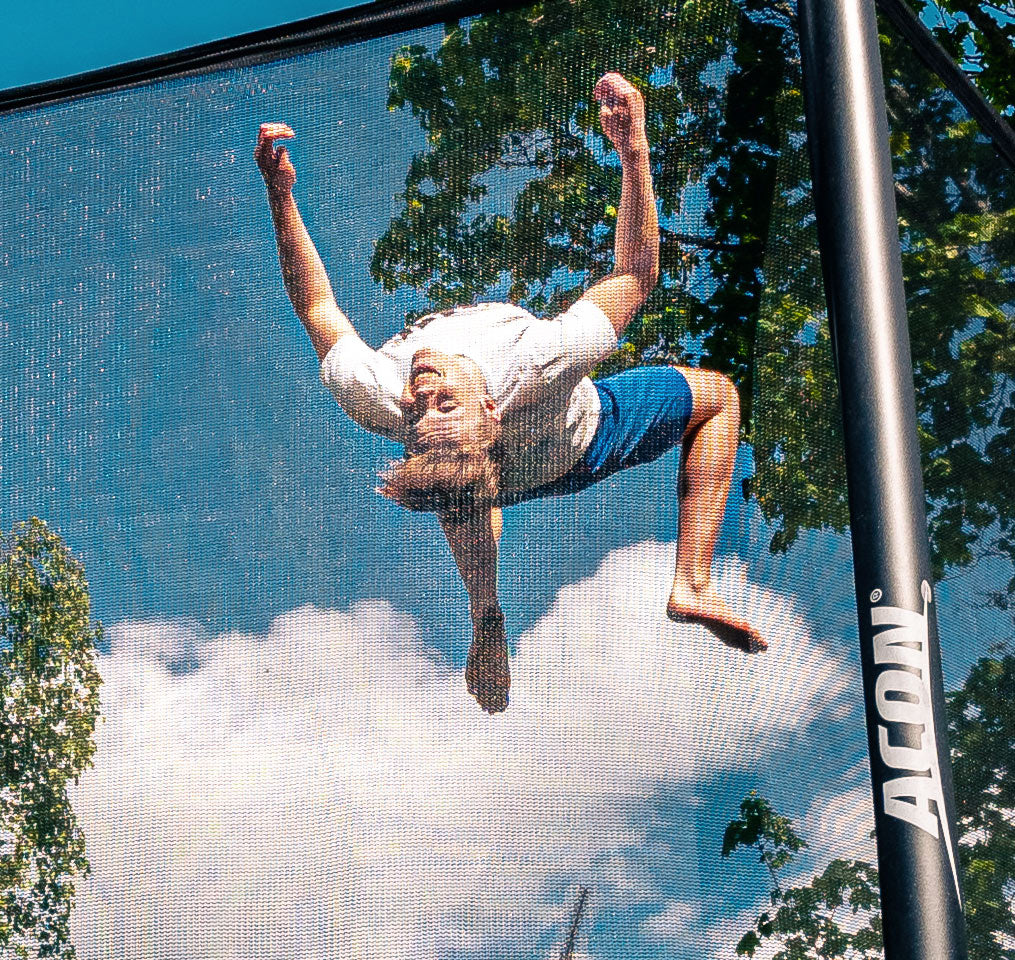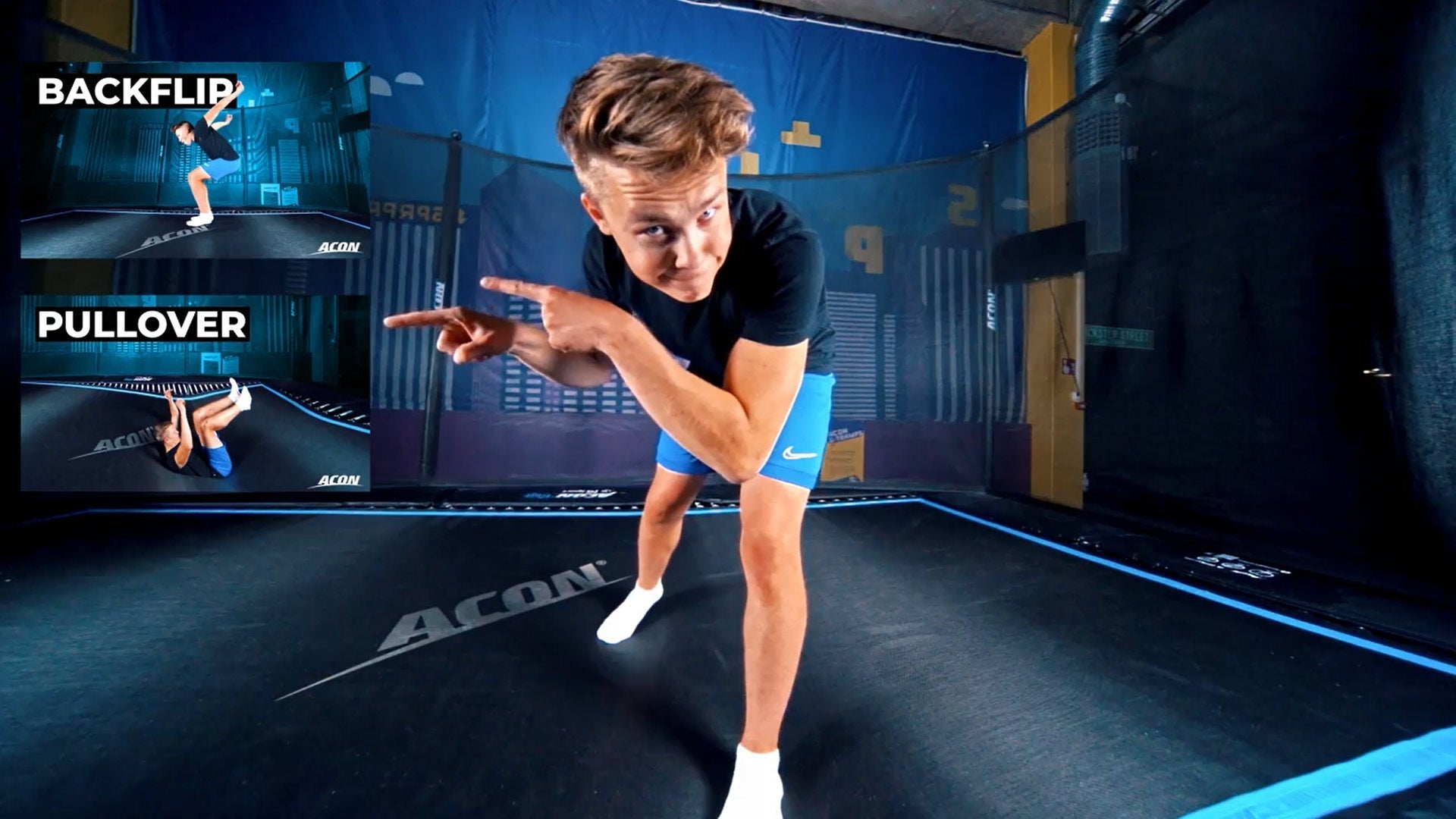Distributacon Inc.
1250 Wayzata Blvd E Unit 1127,
Wayzata, MN 55391, USA
Today’s trampolines have adopted the latest technology to help you in this challenge. So, let’s get cracking.
Average Height of a Trampoline Jump
So, on average, how high can you jump on a trampoline? Well, there is no definitive average height. However, what we can tell you is that in general, most people can jump around 0.8m/2,6ft to 1.5m/4,9ft, which is about the height of most safety nets.
But did you know that Sean Kennedy set an all-time world record for the highest trampoline bounce of 6.73m (22ft 1in) in 2014, in New York? Although this height has since been surpassed, nobody’s higher jump has made it into the record books.
The reason why there isn’t an average for jumping high is that several different factors have to be taken into consideration, such as trampoline flexibility, jumper mass, as well as the jumper’s legs, joints, back and ability.

Is There a Technique to Jump Higher?
In general, no; it’s just a case of getting your momentum going and using your knees to push yourself higher each time you land. That said, many believe there is a technique to jumping world record heights, such as balance, muscle strength and keeping your knees slightly bent to keep jumping.
The bounce of the trampoline, the tautness of the springs and the elasticity of the mat all play a part in learning how to jump higher. Below are our top tips to get you closer to jumping high on a trampoline.

How to Jump Higher on a Trampoline – Top Tips
If you want to master jumping higher on a trampoline, check out the top tips below, mastered by Markku Keski-Oja, a leading trampoline artist.
Tip 1 – Have a Bouncy Trampoline
A big element in achieving a high jump on a trampoline is its springs.
Depending on the trampoline you choose, the ACON trampoline springs are either galvanized steel or piano wire ones, the latter being currently available only for our rectangular trampolines (13 and 16 HD). While both provide exceptional bounce and safe jumps, the piano wire springs take it one step further in terms of performance.
The benefits of piano wire springs are increased performance and ultra-high reliability. Our performance springs have been designed to improve the bounce of a trampoline, but also to create a smoother, more fluent rebound to help jump higher.
Because we’ve harnessed the maximum stretch of our performance springs, the landing is much softer and creates greater kinetic energy to propel you higher, gaining more air time. But you don’t have to buy a new trampoline to take advantage of performance springs and a higher bounce.
Our ACON HD Performance trampoline spring kit comes with our new piano wire springs that deliver maximum stretch and higher jumping power by storing and releasing energy as you rebound. Ideal for upgrading your ACON 13HD or 16HD trampoline, the kit includes new safety net pole sleeves, a string bag and Acon branded stickers.
Once you’ve fitted the performance springs, you will feel an instant difference in performance, a smoother, softer landing, a more powerful rebound and higher jumping. Watch a video below to get a gist on how it looks and feels:


TIP 2 - Learn to jump properly on a trampoline
As we mentioned earlier, jumping high on a trampoline is not as easy as you may think. It’s better to learn how to successfully do the basic jumps before you start tackling high jumping.
Learning how to do tuck jumps, pike jumps, straddle jumps and half or full jumps will help you get a feel for your trampoline’s bounce. It will also help towards learning how to balance yourself throughout your jump and landing.
TIP 3 – Practice high jumps in sets of 10s
When you’ve safely mastered the basic jumps on a trampoline, you can start practicing high jumps. Start gradually jumping higher while making sure you are paying attention to how the jump feels and your body control. Work in sets of 10 jumps intending to jump as high as possible on each jump. Keep and maintain your balance through body control.
However, you must jump safely which means if you lose control of your body or your balance falters, or you are feeling uncomfortable at any time, you must stop. Go back a few steps and get your confidence and control back with a few sets of 10 lower jumps before you start jumping high again.


TIP 4 - Use your hands
When you’re swinging on a swing, you use your legs to propel you; pushing them out in front of you when you go forward and bending your knees so your legs point backwards when in the reverse swing.
It is a similar principle when jumping on a trampoline. Your hands and arms can act as a type of propeller to help you jump higher. So, when you’re jumping on your trampoline, whether you’re still at the stage of mastering the basic jumps or you have progressed to jumping high, throw your hands up in the air, in the direction of the movement, and lower them on the way back down.
TIP 5 - Stay patient and consistent
The adage of practice makes perfect does apply when learning how to jump high on a trampoline. Although you may struggle to control your body and maintain your balance when practicing, don’t give up. Even the professionals have their ‘off’ days and get it wrong sometimes.
Ultimately, safety is of the utmost importance. If you’re feeling uncomfortable or are struggling with body control (that is, sloppy landings, inconsistent jumps, and uncontrolled arms) and balance, don’t be afraid to go back a few steps and practice the basic jumps again. Not only will this build your confidence again, but it will also help to develop your muscle structure, ensuring you are better able to handle high jumping again.

Reasons to Jump Higher
There will be some people who will ask ‘why do you want to jump higher?’ We know three very good reasons:
- Higher jumps allow you to perform more difficult tricks.
- Tricks are more impressive when they are performed high up in the air.
- Practicing jumping high develops body control and balance.
Higher jumps on a trampoline give you more time in the air, which means you can perform more complex, difficult tricks. Tackling one somersault in the air is one thing, and you may think that you’re jumping high enough. But if you want to do more than one somersault and make sure you are straight before landing, you need to jump higher.
When you perform tricks high up in the air, there is no doubt that they are impressive; you can theoretically hear the ‘ooos’ and ‘aaaahs,’ not to mention the intakes of breath when performing but you need time in the air to be able to do tricks. That’s the reason why you need to jump higher.
This brings us to the third reason; developing body control and balance. The key thing to remember at all times is safety. Learning to jump high takes time and practice, and it's important to master the basic jumps first to start the process of building the muscle structure to control your body and balance, allowing you to jump higher in the future.

Why Does a Trampoline Make You Jump Higher?
Sounds like the million-dollar question, but it’s not. There is a scientific basis as to why a trampoline makes you jump higher; let’s explain.
Movement creates energy; when you’re jumping on a trampoline, you are creating your form of energy. Breaking it down, at the beginning of your jump, it’s kinetic energy which is then stored by the trampoline’s springs. When you’re in the air, that energy is transformed into potential energy, particularly at the height of your jump. It’s this energy that pushes you upwards but when you come back down to land on the mat again, that peak energy converts back into kinetic energy because of gravity.
When the trampoline stores that kinetic energy in the springs, it creates an energy power that helps to propel you back up in your next jump. Therefore, at all times during your jump, the jumping energy is either potential or kinetic in its form.
However, the higher you jump the more you are stretching that energy. But energy is also lost through air resistance from the mat and safety pads. Therefore, you will need to work harder to maintain the energy levels needed to jump high on a trampoline and reduce the amount of energy lost.
Of course, your capabilities and strength have an impact on how high you can jump on a trampoline, too. The springs' stored energy can only be maximized by the related force from your legs and body. So, to move the mat and stretch the springs to their maximum to create the biggest power of energy when jumping is largely dependent on how strong your body is and your body weight.
The more flexible the trampoline and its springs, the greater the potential energy created from the force of displacement, and the more likely it is you’ll be able to jump higher.

FAQ on Higher Trampoline Jumps
Is it safe to jump high?
In one word, yes. However, it’s important to make sure that the trampoline isn’t damaged in anyway, that the trampoline enclosure is secured correctly, and that you have the right level of capability to be jumping high and with confidence. Safety is of paramount importance at all times and you must make sure you can predict the bounce of your trampoline. To find out more about making a trampoline bounce safe and view our selection of the safest trampolines, click here.
How can I jump higher on a trampoline?
First and foremost, ensure you have a bouncy trampoline. Next, you must learn the basic jumps first and once you can master these confidently, then you can move on to learning to jump higher. Practice jumping high in sets of 10 jumps, going to your most comfortable highest level. Use your hands and arms to propel you up, and remember, practice makes perfect.
Why would you want to jump higher on a trampoline?
There are three main reasons why you would want to jump higher:
- The higher you jump, the more likely you’ll be able to achieve complex, difficult jumps.
- Tricks are more impressive when they are performed in the air.
- Practicing jumping high on a trampoline helps to develop body control and balance.
What is the World Record for a trampoline jump height?
The world record for the highest trampoline bounce is held by Sean Kennedy who jumped to 6.73m (12ft 1in) in New York, in 2014.
What is air time on a trampoline?
Air time on a trampoline is the time you spend in the air, between leaving the mat and landing back down again.
So, now that you understand there’s more to learning how to jump higher on a trampoline, and you know your target if you’re aiming for a world record, it’s time to get practicing. But, as always, safety first. Before you start jumping, make sure your trampoline is up to the task and if not, get our ACON Air performance springs. Once they’re installedand you’ve mastered all the basic trampoline jumps, it’s time to generate your own air time!













